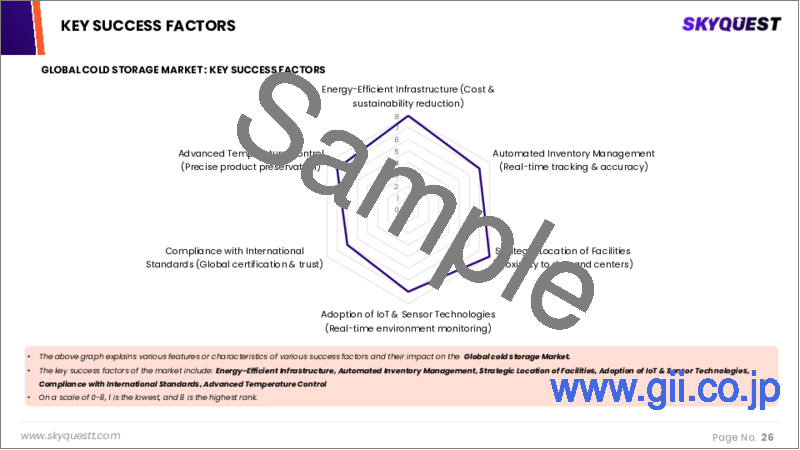|
|
市場調査レポート
商品コード
1724860
冷蔵倉庫の市場規模、シェア、成長分析、タイプ別、温度タイプ別、ストレージ別、用途別、地域別 - 産業予測 2025~2032年Cold Storage Market Size, Share, and Growth Analysis, By Type (Facilities/Services, Equipment), By Temperature Type (Frozen, Chilled), By Storage, By Application, By Region - Industry Forecast 2025-2032 |
||||||
|
|||||||
| 冷蔵倉庫の市場規模、シェア、成長分析、タイプ別、温度タイプ別、ストレージ別、用途別、地域別 - 産業予測 2025~2032年 |
|
出版日: 2025年05月07日
発行: SkyQuest
ページ情報: 英文 165 Pages
納期: 3~5営業日
|
- 全表示
- 概要
- 目次
冷蔵倉庫の世界市場規模は2023年に1,615億米ドルと評価され、2024年の1,908億9,000万米ドルから2032年には7,273億3,000万米ドルに成長し、予測期間(2025-2032年)のCAGRは18.2%で成長する見通しです。
同市場は、生鮮食品のeコマースの急増と倉庫の自動化の進展によって大きな成長を遂げています。モバイルアプリの登場により、顧客は食品を素早く注文し、配達時間を追跡できるようになり、デジタルショッピング体験が向上しています。このシフトにより、生鮮食品へのアクセスが向上する一方で、食品の安全性を確保しコストを削減するための高度な温度モニタリングソリューションや自動在庫管理の需要といった課題も生じています。さらに小売業者は、クリックアンドコレクトや宅配サービスのような戦略を導入して適応しており、実店舗型ビジネスの障壁を低くしています。食品の安全性に対する消費者の意識が高まる中、温度管理されたストレージソリューションへの需要が高まるのは、冷蔵製品に関する食品安全規制の強化を目的とした米国農務省の新たな取り組みと重なり、効果的な冷蔵倉庫実践の重要な必要性が浮き彫りになっています。
目次
イントロダクション
- 調査の目的
- 調査範囲
- 定義
調査手法
- 情報調達
- 二次と一次データの方法
- 市場規模予測
- 市場の前提条件と制限
エグゼクティブサマリー
- 世界市場の見通し
- 供給と需要の動向分析
- セグメント別機会分析
市場力学と見通し
- 市場概要
- 市場規模
- 市場力学
- 促進要因と機会
- 抑制要因と課題
- ポーターの分析
主な市場の考察
- 重要成功要因
- 競合の程度
- 主な投資機会
- 市場エコシステム
- 市場の魅力指数(2024年)
- PESTEL分析
- マクロ経済指標
- バリューチェーン分析
- 価格分析
- 規制情勢
- ケーススタディ
- 技術分析
冷蔵倉庫市場規模:タイプ別& CAGR(2025-2032)
- 市場概要
- 施設・サービス
- 冷蔵倉庫
- プライベート&セミプライベート
- 公共
- 冷蔵室
- 装置
- 急速冷凍機
- ウォークイン冷蔵庫と冷凍庫
- 冷凍庫
- その他
冷蔵倉庫市場規模:温度タイプ別& CAGR(2025-2032)
- 市場概要
- 冷凍
- 冷蔵
冷蔵倉庫市場規模:ストレージ別& CAGR(2025-2032)
- 市場概要
- バルクストレージ
- 生産店舗
- 港湾
冷蔵倉庫市場規模:用途別& CAGR(2025-2032)
- 市場概要
- 食品・飲料
- 果物と野菜
- 果肉・濃縮物
- 乳製品
- 牛乳
- バター
- チーズ
- アイスクリーム
- その他
- 魚、肉、シーフード
- 加工食品
- ベーカリー&菓子店
- その他
- 医薬品
- ワクチン
- 血液バンク
- その他
- その他
冷蔵倉庫市場規模:地域別& CAGR(2025-2032)
- 北米
- 米国
- カナダ
- 欧州
- ドイツ
- スペイン
- フランス
- 英国
- イタリア
- その他欧州地域
- アジア太平洋地域
- 中国
- インド
- 日本
- 韓国
- その他アジア太平洋地域
- ラテンアメリカ
- ブラジル
- その他ラテンアメリカ地域
- 中東・アフリカ
- GCC諸国
- 南アフリカ
- その他中東・アフリカ
競合情報
- 上位5社の比較
- 主要企業の市場ポジショニング(2024年)
- 主な市場企業が採用した戦略
- 最近の市場動向
- 企業の市場シェア分析(2024年)
- 主要企業の企業プロファイル
- 企業の詳細
- 製品ポートフォリオ分析
- 企業のセグメント別シェア分析
- 収益の前年比比較(2022-2024年)
主要企業プロファイル
- Lineage Logistics(USA)
- Americold Logistics LLC(USA)
- Nichirei Corporation(Japan)
- United States Cold Storage(USA)
- NewCold(Netherlands)
- Kloosterboer(Netherlands)
- Tippmann Group(USA)
- Congebec Inc.(Canada)
- Snowman Logistics Pvt Ltd(India)
- Burris Logistics(USA)
- Cloverleaf Cold Storage(USA)
- VX Cold Chain Logistics(China)
- VersaCold Logistics Services(Canada)
- Henningsen Cold Storage Co.(USA)
- Coldman Logistics(India)
- Conestoga Cold Storage(Canada)
- Hanson Logistics(USA)
- RSA Logistics(UAE)
- Nordic Logistics(Denmark)
結論と提言
Global Cold Storage Market size was valued at USD 161.5 billion in 2023 and is poised to grow from USD 190.89 billion in 2024 to USD 727.33 billion by 2032, growing at a CAGR of 18.2% during the forecast period (2025-2032).
The market is experiencing significant growth driven by the surge in e-commerce for fresh produce and advancements in warehouse automation. The advent of mobile apps allows customers to order food quickly and track delivery times, enhancing the digital shopping experience. This shift has increased accessibility to perishable goods while presenting challenges, such as the demand for advanced temperature monitoring solutions and automated inventory management to ensure food safety and reduce costs. Additionally, retailers are adapting by implementing strategies like click-and-collect and home delivery services, lowering barriers for brick-and-mortar businesses. As consumer awareness of food safety rises, increasing demand for temperature-controlled storage solutions coincides with new USDA initiatives aimed at strengthening food safety regulations for refrigerated products, underscoring the critical need for effective cold storage practices.
Top-down and bottom-up approaches were used to estimate and validate the size of the Global Cold Storage market and to estimate the size of various other dependent submarkets. The research methodology used to estimate the market size includes the following details: The key players in the market were identified through secondary research, and their market shares in the respective regions were determined through primary and secondary research. This entire procedure includes the study of the annual and financial reports of the top market players and extensive interviews for key insights from industry leaders such as CEOs, VPs, directors, and marketing executives. All percentage shares split, and breakdowns were determined using secondary sources and verified through Primary sources. All possible parameters that affect the markets covered in this research study have been accounted for, viewed in extensive detail, verified through primary research, and analyzed to get the final quantitative and qualitative data.
Global Cold Storage Market Segments Analysis
Global Cold Storage Market is segmented by Type, Temperature Type, Storage, Application and region. Based on Type, the market is segmented into Facilities/Services and Equipment. Based on Temperature Type, the market is segmented into Frozen and Chilled. Based on Storage, the market is segmented into Bulk Storage, Production Stores and Ports. Based on Application, the market is segmented into Food & Beverages, Pharmaceuticals and Others. Based on region, the market is segmented into North America, Europe, Asia Pacific, Latin America and Middle East & Africa.
Driver of the Global Cold Storage Market
The Global Cold Storage market is primarily driven by the increasing world population and ongoing urbanization, both of which have heightened the demand for perishable goods such as fruits, vegetables, dairy products, and frozen items. As consumers become more focused on the quality and convenience of their food, food retailers and manufacturers are compelled to adopt efficient cold storage systems to ensure that their products remain fresh for extended durations. This trend not only caters to consumer preferences but also addresses the challenges of distribution and preservation in a rapidly evolving market landscape.
Restraints in the Global Cold Storage Market
The global cold storage market faces significant constraints due to its saturation and various operational hurdles. High energy consumption and maintenance costs, along with the expenses associated with advanced cooling systems, pose substantial challenges. These financial burdens are likely to squeeze profit margins, particularly for smaller operators, hindering their ability to invest in necessary infrastructural improvements. Consequently, this situation may stifle growth opportunities within the market, preventing it from reaching its full potential. Addressing these obstacles is crucial for enhancing competitiveness and fostering expansion in the cold storage sector.
Market Trends of the Global Cold Storage Market
The Global Cold Storage market is witnessing significant growth driven by the rapid expansion of e-commerce and online grocery delivery services. As consumers increasingly demand quick access to fresh and frozen products, retailers are compelled to enhance their refrigerated logistics capabilities. This trend is prompting substantial investments in advanced cold storage solutions that ensure optimal preservation and prompt delivery of perishable goods. Moreover, the growing awareness about food safety and quality further fuels this demand. As a result, the cold storage market is poised for robust growth, adapting to evolving consumer preferences and technological innovations in the logistics sector.
Table of Contents
Introduction
- Objectives of the Study
- Scope of the Report
- Definitions
Research Methodology
- Information Procurement
- Secondary & Primary Data Methods
- Market Size Estimation
- Market Assumptions & Limitations
Executive Summary
- Global Market Outlook
- Supply & Demand Trend Analysis
- Segmental Opportunity Analysis
Market Dynamics & Outlook
- Market Overview
- Market Size
- Market Dynamics
- Drivers & Opportunities
- Restraints & Challenges
- Porters Analysis
- Competitive rivalry
- Threat of substitute
- Bargaining power of buyers
- Threat of new entrants
- Bargaining power of suppliers
Key Market Insights
- Key Success Factors
- Degree of Competition
- Top Investment Pockets
- Market Ecosystem
- Market Attractiveness Index, 2024
- PESTEL Analysis
- Macro-Economic Indicators
- Value Chain Analysis
- Pricing Analysis
- Regulatory Landscape
- Case Studies
- Technology Analysis
Global Cold Storage Market Size by Type & CAGR (2025-2032)
- Market Overview
- Facilities/Services
- Refrigerated Warehouse
- Private & Semi-Private
- Public
- Cold Room
- Equipment
- Blast freezer
- Walk-in Cooler and Freezer
- Deep Freezer
- Others
Global Cold Storage Market Size by Temperature Type & CAGR (2025-2032)
- Market Overview
- Frozen
- Chilled
Global Cold Storage Market Size by Storage & CAGR (2025-2032)
- Market Overview
- Bulk Storage
- Production Stores
- Ports
Global Cold Storage Market Size by Application & CAGR (2025-2032)
- Market Overview
- Food & Beverages
- Fruits & Vegetables
- Fruit Pulp & Concentrates
- Dairy Products
- Milk
- Butter
- Cheese
- Ice cream
- Others
- Fish, Meat, and Seafood
- Processed Food
- Bakery & Confectionary
- Others
- Pharmaceuticals
- Vaccines
- Blood Banking
- Others
- Others
Global Cold Storage Market Size & CAGR (2025-2032)
- North America (Type, Temperature Type, Storage, Application)
- US
- Canada
- Europe (Type, Temperature Type, Storage, Application)
- Germany
- Spain
- France
- UK
- Italy
- Rest of Europe
- Asia Pacific (Type, Temperature Type, Storage, Application)
- China
- India
- Japan
- South Korea
- Rest of Asia-Pacific
- Latin America (Type, Temperature Type, Storage, Application)
- Brazil
- Rest of Latin America
- Middle East & Africa (Type, Temperature Type, Storage, Application)
- GCC Countries
- South Africa
- Rest of Middle East & Africa
Competitive Intelligence
- Top 5 Player Comparison
- Market Positioning of Key Players, 2024
- Strategies Adopted by Key Market Players
- Recent Developments in the Market
- Company Market Share Analysis, 2024
- Company Profiles of All Key Players
- Company Details
- Product Portfolio Analysis
- Company's Segmental Share Analysis
- Revenue Y-O-Y Comparison (2022-2024)
Key Company Profiles
- Lineage Logistics (USA)
- Company Overview
- Business Segment Overview
- Financial Updates
- Key Developments
- Americold Logistics LLC (USA)
- Company Overview
- Business Segment Overview
- Financial Updates
- Key Developments
- Nichirei Corporation (Japan)
- Company Overview
- Business Segment Overview
- Financial Updates
- Key Developments
- United States Cold Storage (USA)
- Company Overview
- Business Segment Overview
- Financial Updates
- Key Developments
- NewCold (Netherlands)
- Company Overview
- Business Segment Overview
- Financial Updates
- Key Developments
- Kloosterboer (Netherlands)
- Company Overview
- Business Segment Overview
- Financial Updates
- Key Developments
- Tippmann Group (USA)
- Company Overview
- Business Segment Overview
- Financial Updates
- Key Developments
- Congebec Inc. (Canada)
- Company Overview
- Business Segment Overview
- Financial Updates
- Key Developments
- Snowman Logistics Pvt Ltd (India)
- Company Overview
- Business Segment Overview
- Financial Updates
- Key Developments
- Burris Logistics (USA)
- Company Overview
- Business Segment Overview
- Financial Updates
- Key Developments
- Cloverleaf Cold Storage (USA)
- Company Overview
- Business Segment Overview
- Financial Updates
- Key Developments
- VX Cold Chain Logistics (China)
- Company Overview
- Business Segment Overview
- Financial Updates
- Key Developments
- VersaCold Logistics Services (Canada)
- Company Overview
- Business Segment Overview
- Financial Updates
- Key Developments
- Henningsen Cold Storage Co. (USA)
- Company Overview
- Business Segment Overview
- Financial Updates
- Key Developments
- Coldman Logistics (India)
- Company Overview
- Business Segment Overview
- Financial Updates
- Key Developments
- Conestoga Cold Storage (Canada)
- Company Overview
- Business Segment Overview
- Financial Updates
- Key Developments
- Hanson Logistics (USA)
- Company Overview
- Business Segment Overview
- Financial Updates
- Key Developments
- RSA Logistics (UAE)
- Company Overview
- Business Segment Overview
- Financial Updates
- Key Developments
- Nordic Logistics (Denmark)
- Company Overview
- Business Segment Overview
- Financial Updates
- Key Developments






